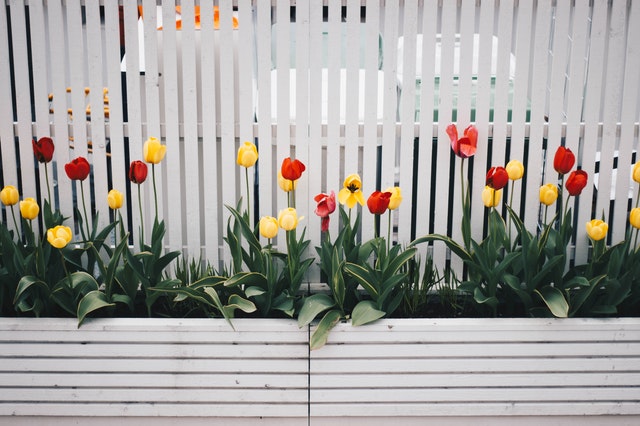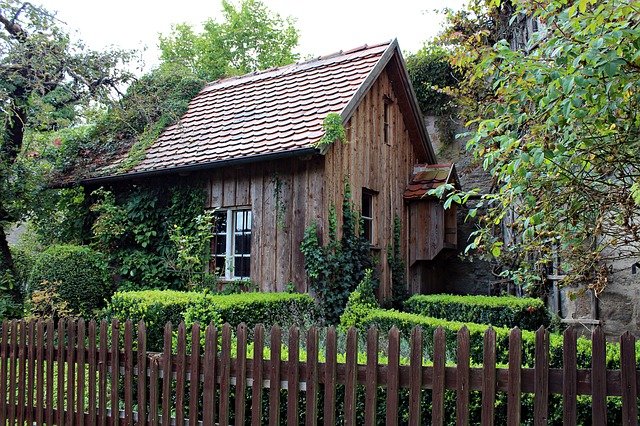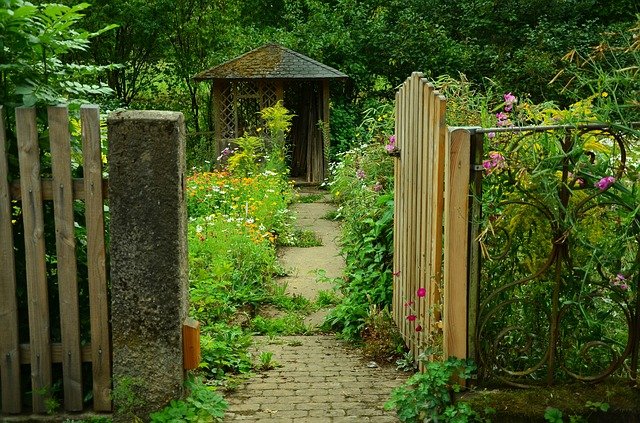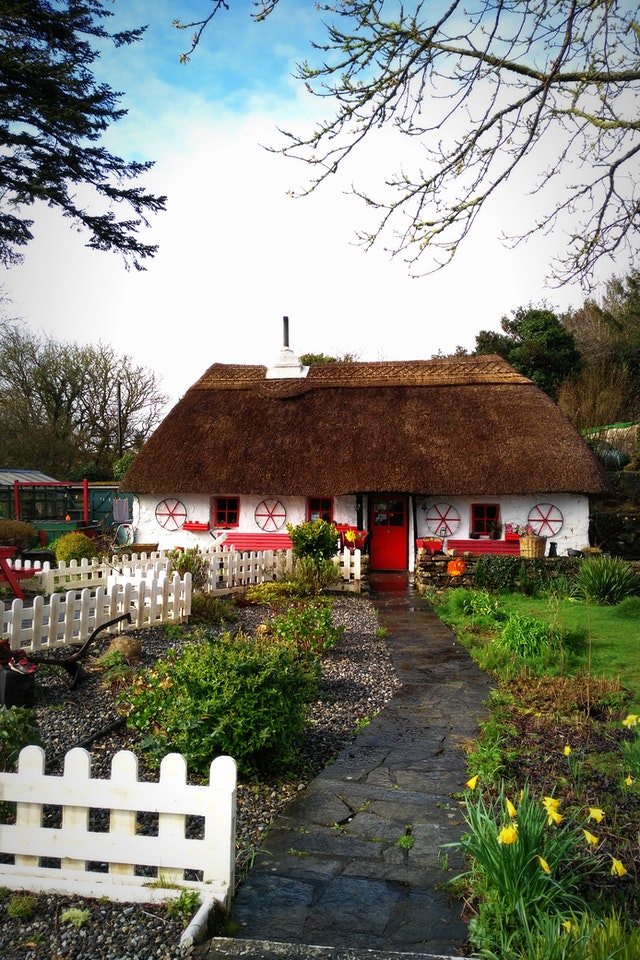Panel Fences
Panel fences go up faster than most other kinds of fences. A panel fence is constructed of panels that are put togther in units up to 8 feet wide. Each panel runs from one post to the next. The panels may be closed board, trelliswork or lattice ,or other designs. Trelliswork panels are a grid of wood or plastic bars set in a frame. Lattice panels are made of flat strips of wood arranged in a diagonal grid. Both of these kinds of panels are ideal for supporting flowering vines such as honeysuckle or morning glories,Which bring color and softness to the fence. Prefabricated fence panels are widely available at building supply stores and lumberyards.
Board Fences
In a board fence, individual boards are nailed next to one another on the rails, with less space between them then in a picket fence. Each board is usually less than 6 inches wide; wider boards are likely to warp. The boards can run vertically, horizontally, or diagonally. For more variety, you can alternate panels of vertical and horizontal boards.
A board-on-board fence has two rows of staggered boards. It looks good from either side, and the staggered design lets in light and air while still affording privacy. This kind of fence can serve as a windbreak if you need it to.
In a close-board fence, a single row of boards if set very close together, with little or no space between the boards. The boards may run vertically or horizontally. This kind of fence looks less welcoming than a board-on-board or louver fence of looser construction. It also can cause odd wind currents and eddies that may damage plants growing near the fence.
When stood on end and angled, the boards become louvers. Louver fences make good wind-breaks, letting air and light into the yard while still affording privacy.
Thin boards may be woven over and under one another, the way a basket is woven, for a different kind of look. A woven fence affords a great deal of privacy, but it can be problematic if the wood is woven so thightly that air cannot penetrate the wood readily. A tight fence is not recommended for a windy location.
To make a board fence higher, or just to add a decorative touch, run lattice or trellis panels along the top. You may even be inspired to train flowering vines to grow up the fence and along the lattice or trellis—it’s a lovely effect.
Post-and-Rail Fences
A post-and-rail fence is composed of vertical posts and two or more horizontal rails (the number of rails is determined by how high the fence needs to be). Post-and-rail fences are seen all over the American countryside. They are easy to put up and not terribly expensive. A low, two-rail fence about 3 feet high can mark property boundaries or serve as a linear accent in the landscape. Higher rail fences can hold livestock.
Stockade-type Fences
A stockade fence can take any of a number of forms, but it is basically a row of slender stakes attached to horizontal rails, with no space between them. A fence of very slender posts is sometimes called a grapestake fence. A palisade fence is similar, except it has no horizontal rails. You can make a palisade from a line of tall stakes, bamboo canes, log sections, poles, or even crooked branches. Regional materials can work, too, such as the ocotillo fences seen in the desert Southwest. A palisade fence is very easy to make—you simply pound the upright posts into the ground. But don’t depend on it to last for many years—palisades can be whimsical and fun, but they are not very strong, especially when they are of any appreciably height.
Metal fences
Wrought iron is a traditional and very formal fencing material that looks at home enclosing elegant city properties or large country estates. Widely used in the 19th century, wrought iron is still employed for fences today. Though less frequently. Wrought-iron fencing is usually simple, but the gates can be elaborate and beautifully detailed. Wrought iron is usually painted black, although white fences are occasionally used. It is best suited to historic and period homes, and it works well with Victorians, especially those with Gothic detailing.
Wrought-iron fences will rust if you don’t keep them painted. If you want the look of wrought iron with lower maintenance, you could look into anodized aluminum fencing, which comes in similar styles.
More contemporary metal fences can be had, too. For the most part they are custom-made art pieces, intriguing and quite beautiful but very costly.
Metal fencing is more often strictly utilitarian. Chain-link fencing shows up in lots of public spaces, but seldom at home. It is expensive, difficult to erect, and too unattractive and institutional-looking for home landscapes. Turkey wire (large-mesh wire fencing often sold with a green vinyl coating) can be use along a driveway or property border, but it’s not much to look at and it’s not very strong. Still, it has the virtue of being inexpensive and is easily installed; you hang it on metal posts driven into the ground. You can camouflage turkey wire and other less-than-attractive fences by training vines on them. See “Vines to Train on Fences” for a list of good candidates.
If you live in deer country—and more and more of us do—fencing your property is almost obligatory unless you don’t mind dealing with serious limitations in the kinds of plants you can grow. Fencing to exclude deer may be of wire mesh or plastic netting, or you can use a fence of electrified wire strands. Deer fencing must be high: 10 feet is usually recommended. Fences this high are difficult to install. Another option is to erect two 4-foot fences, one in side the other, about 3 feet apart. Deer usually will not jump a fence when they see another one beyond it. Camouflage the inner fence from your view by planting shrubs in front of it inside the yard or by training vines on the inside of the fence. To use the double-fence method, you need to have a lot of unused space around the perimeter of your property.
Fencemaking Guidelines
Fences need more maintenance than walls. Painted fences need repainting periodically. Unpainted wood will eventually weather to the point at which boards will need to be replaced. Fences built of rot-resistant redwood, cypress, or cedar need the least maintenance, but they are also expensive. Look for lower grades of these woods for fencing—knots are usually not a problem in a fence. To minimize water damage, provide for drainage below the posts, and bevel or round the tops of the posts, or put metal caps on them. Vinyl fencing needs no maintenance.
Don’t froget to consult your local building codes before beginning construction of a fence along property boundaries. You community may have rules about required setbacks and height restrictions.
Lay out the line of your fence with stakes and string. Then walk along the fence line and examine the site. If you find a big rock where you plan to put a fence post, you may have to adjust the course a bit.
If the fence will be more than 3 feet high, you will need to sink the supporting posts into concrete footings to hold the fence securely upright in strong winds. Footings need to go below the frost line and be at least 18 inches deep for a 3-to 6-foot fence, or 30 inches deep for a fence higher than 6 feet. Make the holes three times the width of the fence post. Dig the post holes 2 inches of gravel in each hole for drainage before you pour the footings.
When the posts are in place and dry, the horizontal rails can be attached. Attaching the rails between the posts can create a fence on its own, or the rails can support pickets, boards, or panels.
One last note about installation: If your fence is not double-sided, erect it with the best side facing out. The side with the visible rails should face in toward your property so you are always putting your best face forward. If you don’t like the idea of looking at the back of the fence, look on the bright side: The rail gives you a place to park your water bottle while you are working in the garden.




